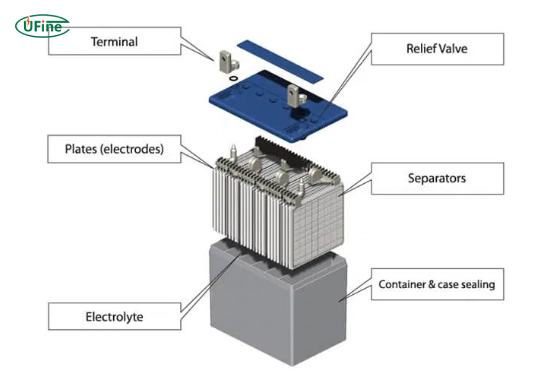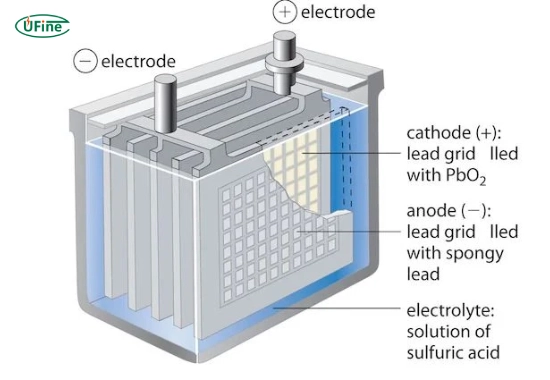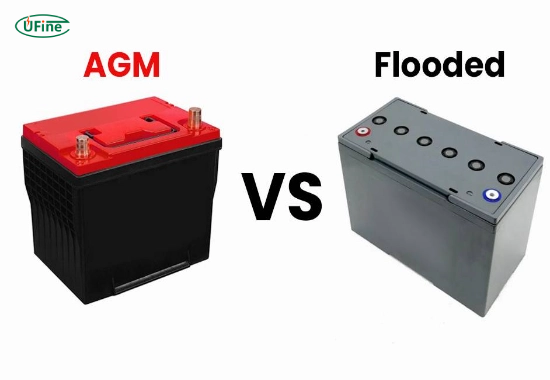When powering your devices, the choice between AGM and flooded batteries can significantly affect performance and longevity. These two battery technologies have distinct characteristics that cater to various applications and user preferences.
Part 1. What is an AGM battery?
AGM batteries, also known as sealed lead-acid (SLA), are valve-regulated lead-acid (VRLA) batteries. Their unique construction sets them apart from traditional flooded batteries. AGM batteries feature a glass mat separator saturated with sulfuric acid, allowing for efficient electrolyte suspension and improved performance.
Advantages of AGM Batteries
- Spill-proof and leak-resistant: AGM batteries’ sealed design makes them ideal for any orientation without the risk of leakage or spills.
- Maintenance-free: Unlike flooded batteries, AGM batteries do not require regular watering or maintenance, saving you time and effort.
- Higher vibration resistance: The glass mat separator in AGM batteries provides superior resistance to vibration, making them suitable for use in vehicles and other applications with high vibration levels.
- Faster charging: Thanks to their unique construction and lower internal resistance, AGM batteries can be charged more quickly than flooded batteries.
Disadvantages of AGM Batteries
- Higher cost: AGM batteries tend to be more expensive than flooded batteries, primarily due to their advanced construction and features.
- Limited deep-cycle capability: While AGM batteries can handle some deep cycling, they may not be as suitable for applications that require frequent deep discharges as flooded batteries.
Part 2. What is a flooded battery?
Flooded batteries, also known as wet cell batteries, are the traditional type of lead-acid batteries. They feature a liquid electrolyte solution surrounding the battery plates, allowing for efficient charge transfer and discharge.
Advantages of Flooded Batteries
- Lower cost: Flooded batteries are generally less expensive than AGM batteries, making them a more budget-friendly option.
- Higher energy density: Flooded batteries can store more energy per unit volume than AGM batteries.
- Longer lifespan: With proper maintenance, flooded batteries can have a longer lifespan than AGM batteries, especially in deep-cycle applications.
Disadvantages of Flooded Batteries
- Require regular maintenance: Flooded batteries must be checked regularly for proper electrolyte levels and may require watering to maintain optimal performance.
- Risk of spills and leaks: Flooded batteries, due to their liquid electrolyte, must be kept upright to prevent spills and leaks.
- Slower charging: Flooded batteries typically have a slower charging rate compared to AGM batteries.
Part 3. Key differences between AGM and flooded batteries
When choosing between AGM and flooded batteries, it’s essential to consider the key differences that may impact your specific application.
Construction and Design
AGM batteries feature a glass mat separator saturated with sulfuric acid. In contrast, flooded batteries have a liquid electrolyte solution surrounding the battery plates.
Maintenance Requirements
AGM batteries are maintenance-free, while flooded batteries require regular checks for proper electrolyte levels and may need watering to maintain optimal performance.
Spill and Leak Risk
AGM batteries are spill-proof and leak-resistant, making them suitable for any orientation. Users must keep flooded batteries upright to prevent spills and leaks.
Charging Rates
Users can charge AGM batteries more quickly than flooded batteries due to their lower internal resistance.
Lifespan and Deep-Cycle Capability
With proper maintenance, flooded batteries can have a longer lifespan than AGM batteries, especially in deep-cycle applications. AGM batteries may not be as suitable for frequent deep discharges.
| Feature | AGM Battery | Flooded Battery |
|---|---|---|
| Construction | Glass mat separator saturated with sulfuric acid | Liquid electrolyte solution surrounding the battery plates |
| Maintenance | Maintenance-free | Requires regular checks for proper electrolyte levels and watering |
| Spill and Leak Risk | Spill-proof and leak-resistant | Risk of spills and leaks if not kept upright |
| Charging Rates | Faster charging due to lower internal resistance | Slower charging compared to AGM batteries |
| Lifespan and Deep-Cycle Capability | May not be as suitable for frequent deep discharges | Longer lifespan with proper maintenance, especially in deep-cycle applications |
Part 4. AGM vs flooded battery: applications and use cases
AGM and flooded batteries have their strengths and are suitable for various applications.
Automotive Applications
- Many modern vehicles use AGM batteries because of their vibration resistance and maintenance-free design. Manufacturers frequently use them as starting batteries to provide the necessary power for engine cranking.
- Flooded batteries are still widely used in older vehicles and as deep-cycle batteries for applications such as RV houses and marine batteries.
Renewable Energy Systems
- AGM batteries are popular for solar energy storage systems due to their maintenance-free nature and resistance to vibration and shock.
- Renewable energy systems also use flooded batteries, particularly in large-scale, high-cost applications.
Backup Power Systems
- Many users prefer AGM batteries for backup power systems like uninterruptible power supplies (UPS) because of their spill-proof design and fast charging capabilities.
- Large-scale backup power systems, such as those in hospitals and data centers, typically use flooded batteries where cost and energy density are key considerations.
Part 5. AGM vs flooded battery: choosing the right battery
When choosing between AGM and flooded batteries, consider the following factors:
- Cost: If budget is a primary concern, flooded batteries may be the more cost-effective.
- Maintenance requirements: AGM is the better choice if you prefer a maintenance-free battery.
- Vibration and shock resistance: For applications with high vibration levels, AGM batteries offer superior protection.
- Charging requirements: Choose AGM if you need a battery that can charge quickly.
- Deep-cycle capability: Flooded batteries may suit applications requiring frequent deep discharges.
Part 6. FAQs
-
What is the main difference between AGM and flooded batteries?
The main difference between AGM and flooded batteries is their construction. AGM batteries use a glass mat separator saturated with sulfuric acid. In contrast, flooded batteries have a liquid electrolyte solution surrounding the battery plates. -
Are AGM batteries maintenance-free?
AGM batteries are maintenance-free and do not require regular watering or checks for proper electrolyte levels. -
Can AGM batteries be used in any orientation?
AGM batteries are spill-proof and leak-resistant, so you can use them in any orientation without the risk of spillage. -
Do AGM batteries have a longer lifespan than flooded batteries?
Not necessarily. With proper maintenance, flooded batteries can have a longer lifespan than AGM batteries, especially in deep-cycle applications. -
Are AGM batteries more expensive than flooded batteries?
AGM batteries are more expensive than flooded batteries due to their advanced construction and features.
Related Tags:
More Articles

How to Choose the Best Floor Scrubber Battery for Commercial Cleaning?
Selecting the ideal floor scrubber battery ensures a long runtime, rapid charging, and minimal maintenance for efficient commercial cleaning operations.
Battery for Blower vs Battery for Leaf Vacuum: Which One Should You Choose?
Battery for blower vs leaf vacuum—learn the key differences in power, fit, and runtime to choose the right battery for your outdoor tool needs.
How to Choose the Right Battery for Blower?
Choosing the right blower battery? Consider voltage, capacity, chemistry & usage. This guide helps match the best battery for peak performance.
How to Choose the Best Insulated Battery Box for Lithium Batteries?
Choosing the Best Insulated Battery Box for Lithium Batteries? Discover key factors such as size, material, and safety for optimal protection and performance.
7 Critical Elements on a Lithium Battery Shipping Label
What must be on a lithium battery shipping label? Learn 7 key elements to ensure safety, legal compliance, and correct handling across all transport modes.







